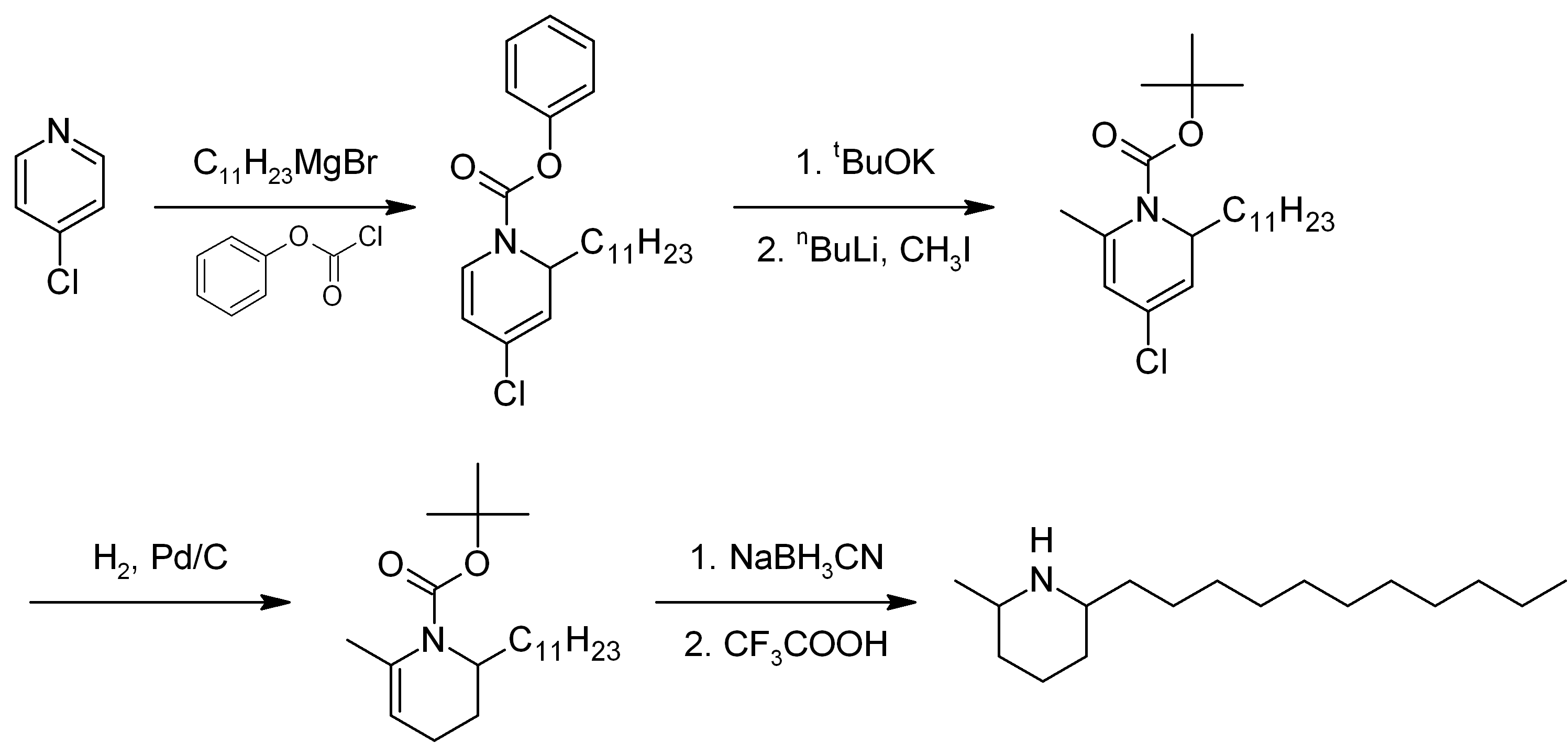Solenopsin Synthesis on:
[Wikipedia]
[Google]
[Amazon]
Solenopsin is a lipophilic alkaloid with the molecular formula C17H35N found in the venom of fire ants (''Solenopsis''). It is considered the primary toxin in the venom and may be the component responsible for the

cardiorespiratory failure
Respiratory arrest is a sickness caused by apnea (cessation of breathing) or respiratory dysfunction severe enough it will not sustain the body (such as agonal breathing). Prolonged apnea refers to a patient who has stopped breathing for a long per ...
in people who experience excessive fire ant stings.
Structurally solenopsins are a piperidine ring with a methyl group substitution at position 2 and a long hydrophobic chain at position 6. They are typically oily at room temperature, water-insoluble, and present an absorbance peak at 232 nanometers. Fire ant venom contains other chemically related piperidines which make purification of solenopsin from ants difficult. Therefore, solenopsin and related compounds have been the target of organic synthesis
Organic synthesis is a special branch of chemical synthesis and is concerned with the intentional construction of organic compounds. Organic molecules are often more complex than inorganic compounds, and their synthesis has developed into one o ...
from which pure compounds can be produced for individual study. Originally synthesized in 1993, several groups have designed novel and creative methods of synthesizing enantiopure solenopsin and other alkaloidal components of ant venom.
Total synthesis
The total synthesis of solenopsin has been described by several methods. A proposed method of synthesis(Figure 1) starts with alkylation of 4-chloropyridine with aGrignard reagent
A Grignard reagent or Grignard compound is a chemical compound with the general formula , where X is a halogen and R is an organic group, normally an alkyl or aryl. Two typical examples are methylmagnesium chloride and phenylmagnesium bromide ...
derived from 1-bromoundecane, followed by reaction with phenyl chloroformate to form 4-chloro-1-(phenoxycarbonyl)-2-''n''-undecyl-1,2-dihydropyridine. The phenylcarbamate is converted to the BOC protecting group, and then pyridine is methylated at the 6 position. The pyridine ring is then reduced to a tetrahydropyridine via catalytic hydrogenation with Pd/C and then further reduced with sodium cyanoborohydride to a piperidine ring. The BOC group is finally removed to yield solenopsin. A number of analogs
Analog or analogue may refer to:
Computing and electronics
* Analog signal, in which information is encoded in a continuous variable
** Analog device, an apparatus that operates on analog signals
*** Analog electronics, circuits which use analog ...
have been synthesized using modifications of this procedure.
A shorter method of synthesis stemming from commercially-available lutidine Lutidine is the trivial name used to describe the chemical compounds which are dimethyl derivatives of pyridine
Pyridine is a basic heterocyclic organic compound with the chemical formula . It is structurally related to benzene, with one met ...
has been more recently proposed.
:
Biological activities
Solenopsins are described as toxic against vertebrates and invertebrates. For example, the compound known as isosolenopsin A has been demonstrated to have strong insecticidal effects which may play a central role in the biology of fire ants. In addition to its toxicity, solenopsis has a number of other biological activities. It inhibitsangiogenesis
Angiogenesis is the physiological process through which new blood vessels form from pre-existing vessels, formed in the earlier stage of vasculogenesis. Angiogenesis continues the growth of the vasculature by processes of sprouting and splitting ...
'' in vitro'' via the phosphoinositide 3-kinase
Phosphoinositide 3-kinases (PI3Ks), also called phosphatidylinositol 3-kinases, are a family of enzymes involved in cellular functions such as cell growth, proliferation, differentiation, motility, survival and intracellular trafficking, which i ...
(PI3K) signaling pathway, inhibits neuronal nitric oxide synthase (nNOS) in a manner that appears to be non-competitive with L-arginine, and inhibits quorum-sensing
In biology, quorum sensing or quorum signalling (QS) is the ability to detect and respond to cell population density by gene regulation. As one example, QS enables bacteria to restrict the expression of specific genes to the high cell densities at ...
signaling in some bacteria. The biological activities of solenopsins have led researchers to propose a number of biotechnological and biomedical applications for these compounds. For instance, mentioned anti-bacterial and interference in quorum-sensing signalling apparently provide solenopsins with considerable anti-biofilm activity, which suggests the potential of analogs as new disinfectants and surface-conditioning agents. Also, solenopsins have been demonstrated to inhibit cell division and viability of Trypanosoma cruzi, the cause of Chagas disease
Chagas disease, also known as American trypanosomiasis, is a tropical parasitic disease caused by ''Trypanosoma cruzi''. It is spread mostly by insects in the subfamily ''Triatominae'', known as "kissing bugs". The symptoms change over the cou ...
, which suggests these alkaloids as potential chemotherapeutic drugs.
Solenopsin and analogs share structural and biological properties with the sphingolipid ceramide, a major endogenous regulator of cell signaling, inducing mitophagy and anti-proliferative effects in different tumor cell lines.
Synthetic analogs
Analog or analogue may refer to:
Computing and electronics
* Analog signal, in which information is encoded in a continuous variable
** Analog device, an apparatus that operates on analog signals
*** Analog electronics, circuits which use analog ...
of solenopsin are being studied for the potential treatment of psoriasis.
References
Further reading
* {{cite journal , doi = 10.1039/NP9971400637 , title = Pyrrole, pyrrolidine pyridine, piperidine, azepine and tropane alkaloids , year = 1997 , author = O'Hagan, David , journal =Natural Product Reports
''Natural Product Reports'' is a monthly peer-reviewed scientific journal published by the Royal Society of Chemistry. It publishes reviews commissioned by the editorial board on all areas of natural products research. The Executive Editor is Richa ...
, type = Review , volume = 14 , pages = 637 , issue = 6
Piperidine alkaloids
Total synthesis
Toxins